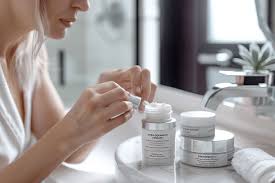
Demystifying Retinol: The Ultimate Guide to Understanding Its Benefits and Usage
If you’ve ever ventured into the world of skincare, you’ve likely come across the term retinol.
Whether in a serum, face cream, or night treatment, retinol seems to be a key ingredient in almost every anti-aging product.
But despite its widespread use, there’s still quite a bit of confusion surrounding it. What is retinol? How does it work?
And, most importantly, how do you incorporate it into your skincare routine without causing irritation? Let’s dive in and demystify this powerful skincare ingredient.
What Exactly is Retinol?
At its core, retinol is simply another name for vitamin A, an essential nutrient that plays a significant role in various bodily functions, including vision, immune system support, and skin health.
But in skincare, retinol refers to a specific type of retinoid, which is a family of compounds derived from vitamin A. Other types of retinoids include retinoic acid, retinal, and retinyl palmitate.
Retinol is widely known for its anti-aging and acne-fighting properties. This makes it a star ingredient in the skincare world, trusted by many to rejuvenate and revitalize the skin.
Retinol has gained fame because it helps the skin maintain its natural renewal process, making it smoother and more youthful-looking.
How Does Retinol Work?
Retinol works its magic by increasing cell turnover in the skin. This means it helps shed old, dead skin cells and promotes the production of fresh, healthy cells. Here’s how it works step-by-step:
Increased Cell Turnover: As we age, the skin’s natural ability to shed dead skin cells slows down. Retinol accelerates this process, preventing a buildup of dead cells that can make skin look dull and lifeless.
Improves Skin Texture: With continued use, retinol can help improve skin texture by smoothing out rough patches, reducing the appearance of fine lines and wrinkles, and giving the skin a more even tone.
Prevents Clogged Pores: Retinol can also help prevent clogged pores by breaking down the dead skin cells that tend to block them. This makes it particularly beneficial for those dealing with acne or congested skin.
Anti-Aging Benefits: By encouraging faster skin cell renewal, retinol helps promote collagen production, leading to firmer, more youthful-looking skin.
Retinol vs. Retinoids: What’s the Difference?
While retinol is often used interchangeably with the broader term retinoids, there’s a crucial distinction between the two. All retinols are technically retinoids, but not all retinoids are retinol.
Retinoids: These are a broader class of vitamin A derivatives that typically accelerate cell turnover at a faster rate compared to retinol.
Because of this, retinoids are often used in the treatment of severe acne or conditions where faster skin renewal is required.
However, their potency can make them prone to causing skin irritation or dryness, especially for those with sensitive skin.
Retinol: In contrast, retinol is a gentler, more gradual version of retinoids.
While it still promotes healthy cell turnover, it does so at a more controlled pace, which makes it a better option for those looking for long-term skin rejuvenation without the risk of irritation.
In short, retinol offers the benefits of retinoids, but it’s gentler and suitable for most skin types, even sensitive ones, when used correctly.
How to Incorporate Retinol into Your Skincare Routine
One of the best things about retinol is its versatility.
It’s available in over-the-counter serums, face creams, and restorative night creams, making it easier than ever to integrate into your skincare regimen.
However, it’s important to understand how to use retinol properly to get the most out of it.
Start Slow: If you’re new to retinol, it’s always best to start with a product that contains low concentrations of the active ingredient.
This will help your skin gradually adjust to its effects without overwhelming it. Starting with a 0.25% or 0.5% retinol product is ideal.
Frequency: Retinol can be potent, so it’s crucial to introduce it slowly. Begin by using it two to three times per week, gradually increasing the frequency as your skin gets accustomed to it.
Over time, you can move up to more frequent applications or higher concentrations.
Use at Night: Retinol works best when applied at night because it can increase the skin’s sensitivity to sunlight.
During the day, you can apply sunscreen to protect your skin from harmful UV rays, but nighttime is when the skin naturally repairs itself, making it the ideal time for retinol to work.
Moisturize: Since retinol can cause dryness or peeling in some people, it’s essential to follow up with a moisturizer.
This helps to hydrate and nourish your skin after the active ingredient has done its job.
Never Skip Sunscreen: As mentioned, retinol can make your skin more susceptible to sun damage, so it’s important to apply sunscreen every morning—without exception.
Even if you’re using retinol only at night, daily sunscreen application is a must.
What to Look for When Buying Retinol Products
When shopping for retinol-based products, not all formulations are created equal. Here are some important things to consider before making a purchase:
Concentration: As mentioned earlier, it’s important to start with a lower concentration of retinol if you’ve never used it before.
Look for products with 0.25% or 0.5% retinol, and work your way up from there. Some products also offer a gradual-release form of retinol, which helps minimize irritation.
Formulation: Retinol products come in various forms, including serums, creams, and oils. Depending on your skin type, you might prefer a lighter serum or a richer cream if you have dry or sensitive skin.
For oily skin, a gel-based formulation might work best.
Packaging: Retinol can lose its potency when exposed to light and air, so always choose products that are packaged in opaque, air-tight containers to protect the integrity of the ingredient.
Dermatologist Recommendations: It’s always a good idea to choose products that have been recommended by a dermatologist. They can guide you toward the right strength and formulation for your skin type and concerns.
Should You Consult a Dermatologist Before Using Retinol?
While retinol is widely available over the counter, it’s always a good idea to have a skin examination by a qualified dermatologist before starting a retinol-based treatment.
This is particularly important if you have sensitive skin or are dealing with severe acne or other skin conditions.
A dermatologist can help you determine:
Whether retinol is suitable for your skin.
Which formulation and concentration would work best for your skin type.
How to properly incorporate retinol into your skincare routine to avoid irritation.
In some cases, using the wrong concentration or a retinol product not suited for your skin type can lead to irritation, excessive dryness, or worsening of existing skin issues.
So, professional evaluation can save you from wasting time or aggravating your skin.
Conclusion: Retinol for Radiant, Youthful Skin
Retinol remains one of the most effective ingredients for anti-aging, acne treatment, and overall skin rejuvenation.
Whether you’re looking to reduce fine lines, improve skin texture, or prevent future breakouts, retinol can offer remarkable benefits when used correctly.
By understanding how it works, starting slowly, and taking necessary precautions (such as wearing sunscreen), you can incorporate retinol into your routine for smooth, radiant, and youthful skin.
If you’re unsure where to start, consulting a dermatologist can help you make the best decision for your skin’s unique needs.
But once you’ve found the right retinol product for your skin type, you’ll be on your way to achieving glowing, healthy skin.


